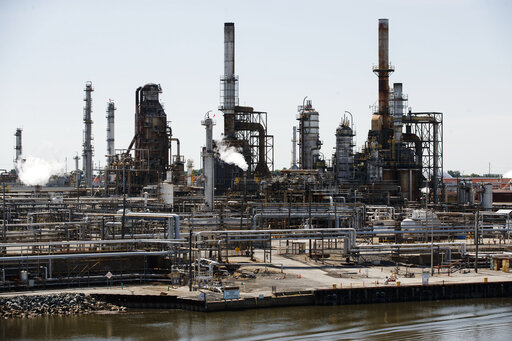NEW YORK, Oct 16 — An old, degraded piece of metal pipe that had not been tested for corrosion led to a June fire and explosions at the Philadelphia Energy Solutions oil refinery, the U.S. Chemical Safety and Hazard Investigation Board said on Wednesday.
The pipe fitting gave way around 4:00 a.m. ET on June 21, releasing propane containing more than 3,200 pounds of highly toxic chemical hydrofluoric acid (HF) that escaped into the atmosphere, the CSB said.
That led to three separate explosions that hurled pieces of the refinery across the nearby Schuylkill River and onto highways, causing a blaze that was visible for miles, and destroying an alkylation unit that uses HF to produce components of high-octane gasoline.
No one was killed in the explosion, and only five minor injuries were reported. However, Philadelphia Energy Solutions filed for bankruptcy a month later and shut down the 335,000 barrel-per day refinery, the largest on the U.S. East Coast.
About 1,100 workers of the plant were laid off without health benefits or severance pay.
“We need to focus on making sure that this type of an explosion at a refinery doesn’t happen anymore because it’s just a matter of time before the facts are just a little bit different and people die or are critically injured,” CSB Interim Director Kristen Kulinowski said at a news conference.
The report confirms what sources told Reuters in August, that the company was expected to say that hydrofluoric acid was released during the incident. HF can burn the eyes, skin and lungs, and can be fatal.
A process operator at the plant quickly activated a fail-safe that dumped a large quantity of HF into a protected vessel so that more of the acid was not released, CSB said.
While CSB officials said they were unaware of health complaints tied to the leaked chemical, Reuters spoke to residents of the South Philadelphia neighborhood surrounding the refinery in the days after the fire, who complained of burning eyes, itchy skin and other symptoms linked to HF exposure.
The PES incident has put a new spotlight on HF, which has come under criticism by the CSB and refinery worker unions for its use in U.S. refineries in populated areas.
The ruptured pipe fitting, known as an elbow, was also found to have a metal composition that included high levels of copper and nickel, failing to meet industry standards, the agency said.
“The elbow that ruptured corroded faster than the rest of the piping,” CSB investigator Lauren Grim said at a press conference.
After the blast, the thinnest portion of the pipe fitting was found to be half the thickness of a credit card, said CSB, a non-regulatory federal agency.
While the broader pipe system in the destroyed unit had been periodically measured for thickness to detect corrosion, the individual ruptured piece had not been inspected, the CSB said.
Pipe thinned by corrosion was found by the board to be the cause of the 2012 explosion at Chevron Corp’s Richmond, California, refinery and the 2009 blast at the Silver Eagle refinery in Woods Cross, Utah.
The CSB, which has no regulatory or enforcement power, is authorized under the U.S. Clean Air Act to determine the cause of chemical plant explosions and fires and to make recommendations to prevent them in the future. The board’s investigation is ongoing and a final report with the recommendations will be issued early next year, CSB officials said.
–Additional reporting by Erwin Seba.
Was this article valuable?
Here are more articles you may enjoy.


 California Governor Seeks $200M to Replace EV Tax Credits Cut by Trump
California Governor Seeks $200M to Replace EV Tax Credits Cut by Trump  JPMorgan Wins Gender Pay Gap Dispute Against London Analyst
JPMorgan Wins Gender Pay Gap Dispute Against London Analyst  What The Return of California’s ‘Death Discount’ Means for Litigation
What The Return of California’s ‘Death Discount’ Means for Litigation  Cyber Breach Affected 750,000 Canadian Investors, Regulator Says
Cyber Breach Affected 750,000 Canadian Investors, Regulator Says 